OHS6205: Risk Assessment for Chlorine Dioxide at Kingston Ltd
VerifiedAdded on 2023/01/19
|14
|3393
|86
Report
AI Summary
This report presents a comprehensive risk assessment of chlorine dioxide, focusing on its use at Kingston Manufacturers Limited, a paper milling company. The assessment identifies workplace hazards, including leaks and spills, using analytical methods like workplace air monitoring and biological m...
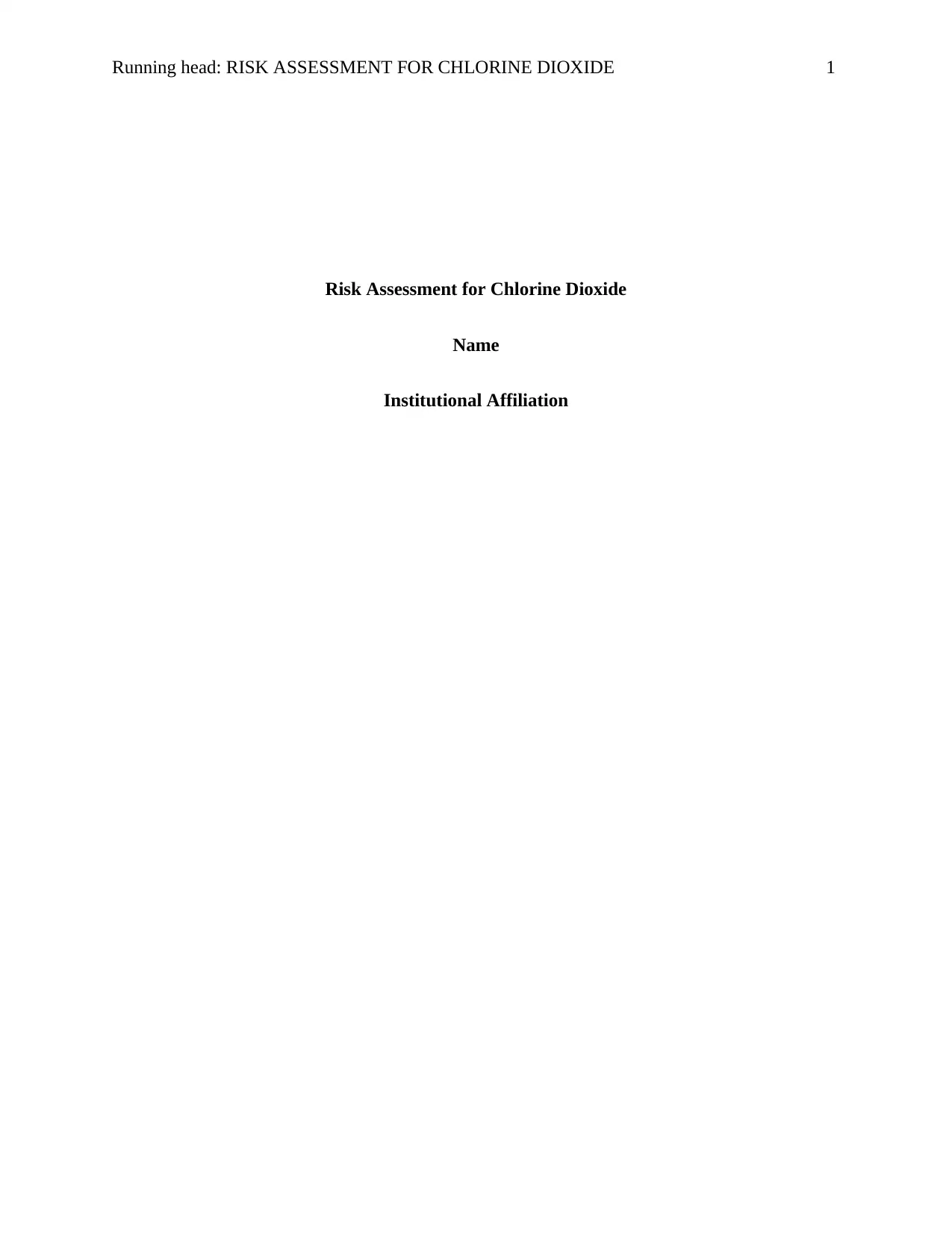
Running head: RISK ASSESSMENT FOR CHLORINE DIOXIDE 1
Risk Assessment for Chlorine Dioxide
Name
Institutional Affiliation
Risk Assessment for Chlorine Dioxide
Name
Institutional Affiliation
Paraphrase This Document
Need a fresh take? Get an instant paraphrase of this document with our AI Paraphraser

RISK ASSESSMENT FOR CHLORINE DIOXIDE 2
Table of Contents
1.0 Executive summary..............................................................................................................3
2.0 Introduction...........................................................................................................................3
3.0 Risk Assessment...................................................................................................................4
3.1 Analytical methods of Hazard identification....................................................................4
3.1.1 Workplace air monitoring..........................................................................................4
3.1.2 Biological monitoring of staff...................................................................................5
3.2 Health hazard information................................................................................................5
3.2.1 Who is affected?........................................................................................................5
3.2.2 Acute Health Effects..................................................................................................5
3.2.3 Chronic health effects................................................................................................6
3.3 Risk evaluation and control measures...............................................................................6
3.3.1 Workplace Controls and Safety Practices..................................................................6
3.3.2 Personal protective measures.....................................................................................8
3.3.3 Handling and Storage................................................................................................9
4.0 Recommendation and implementation.................................................................................9
5.0 Conclusion..........................................................................................................................10
6.0 Appendix.............................................................................................................................12
7.0 References...........................................................................................................................13
Table of Contents
1.0 Executive summary..............................................................................................................3
2.0 Introduction...........................................................................................................................3
3.0 Risk Assessment...................................................................................................................4
3.1 Analytical methods of Hazard identification....................................................................4
3.1.1 Workplace air monitoring..........................................................................................4
3.1.2 Biological monitoring of staff...................................................................................5
3.2 Health hazard information................................................................................................5
3.2.1 Who is affected?........................................................................................................5
3.2.2 Acute Health Effects..................................................................................................5
3.2.3 Chronic health effects................................................................................................6
3.3 Risk evaluation and control measures...............................................................................6
3.3.1 Workplace Controls and Safety Practices..................................................................6
3.3.2 Personal protective measures.....................................................................................8
3.3.3 Handling and Storage................................................................................................9
4.0 Recommendation and implementation.................................................................................9
5.0 Conclusion..........................................................................................................................10
6.0 Appendix.............................................................................................................................12
7.0 References...........................................................................................................................13
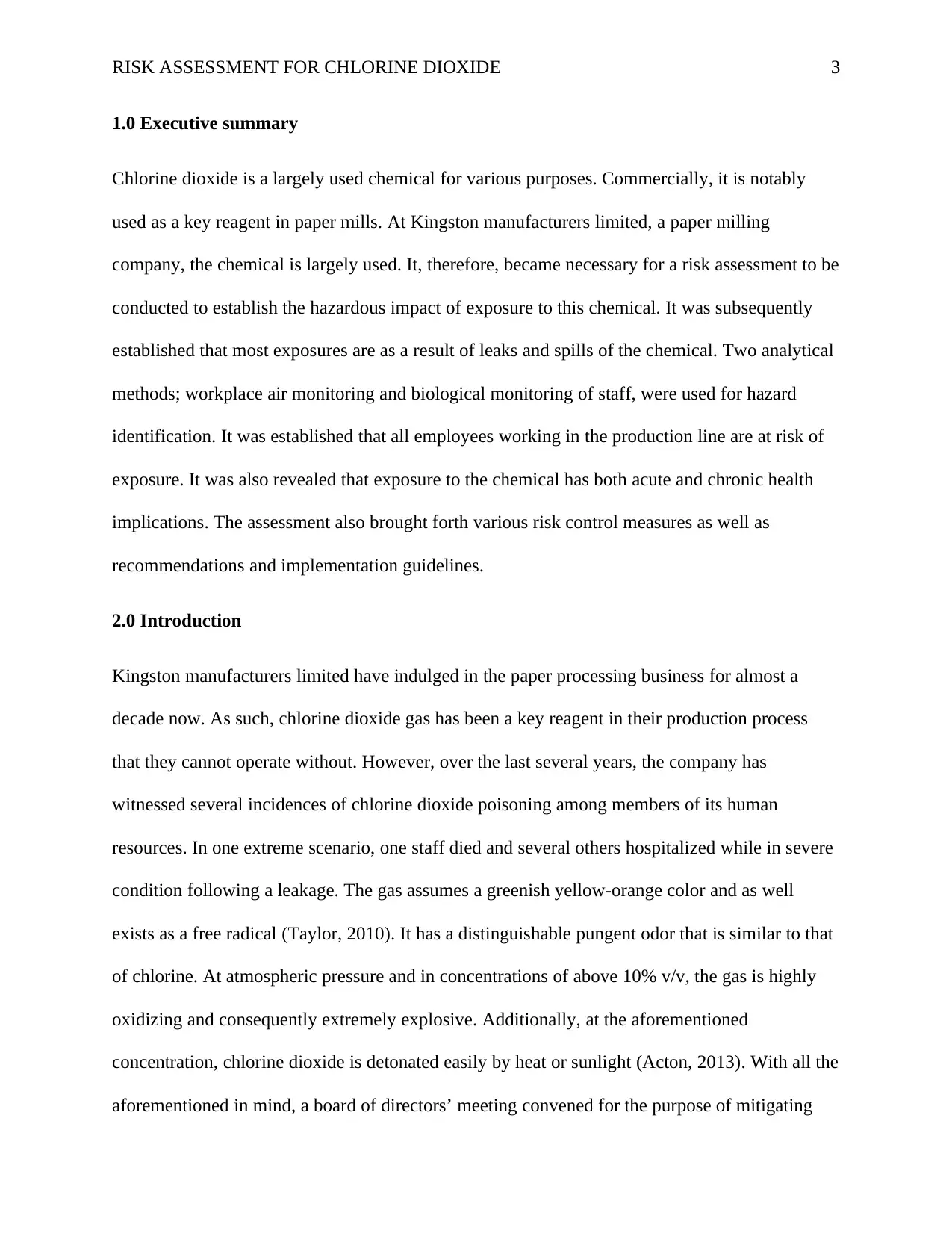
RISK ASSESSMENT FOR CHLORINE DIOXIDE 3
1.0 Executive summary
Chlorine dioxide is a largely used chemical for various purposes. Commercially, it is notably
used as a key reagent in paper mills. At Kingston manufacturers limited, a paper milling
company, the chemical is largely used. It, therefore, became necessary for a risk assessment to be
conducted to establish the hazardous impact of exposure to this chemical. It was subsequently
established that most exposures are as a result of leaks and spills of the chemical. Two analytical
methods; workplace air monitoring and biological monitoring of staff, were used for hazard
identification. It was established that all employees working in the production line are at risk of
exposure. It was also revealed that exposure to the chemical has both acute and chronic health
implications. The assessment also brought forth various risk control measures as well as
recommendations and implementation guidelines.
2.0 Introduction
Kingston manufacturers limited have indulged in the paper processing business for almost a
decade now. As such, chlorine dioxide gas has been a key reagent in their production process
that they cannot operate without. However, over the last several years, the company has
witnessed several incidences of chlorine dioxide poisoning among members of its human
resources. In one extreme scenario, one staff died and several others hospitalized while in severe
condition following a leakage. The gas assumes a greenish yellow-orange color and as well
exists as a free radical (Taylor, 2010). It has a distinguishable pungent odor that is similar to that
of chlorine. At atmospheric pressure and in concentrations of above 10% v/v, the gas is highly
oxidizing and consequently extremely explosive. Additionally, at the aforementioned
concentration, chlorine dioxide is detonated easily by heat or sunlight (Acton, 2013). With all the
aforementioned in mind, a board of directors’ meeting convened for the purpose of mitigating
1.0 Executive summary
Chlorine dioxide is a largely used chemical for various purposes. Commercially, it is notably
used as a key reagent in paper mills. At Kingston manufacturers limited, a paper milling
company, the chemical is largely used. It, therefore, became necessary for a risk assessment to be
conducted to establish the hazardous impact of exposure to this chemical. It was subsequently
established that most exposures are as a result of leaks and spills of the chemical. Two analytical
methods; workplace air monitoring and biological monitoring of staff, were used for hazard
identification. It was established that all employees working in the production line are at risk of
exposure. It was also revealed that exposure to the chemical has both acute and chronic health
implications. The assessment also brought forth various risk control measures as well as
recommendations and implementation guidelines.
2.0 Introduction
Kingston manufacturers limited have indulged in the paper processing business for almost a
decade now. As such, chlorine dioxide gas has been a key reagent in their production process
that they cannot operate without. However, over the last several years, the company has
witnessed several incidences of chlorine dioxide poisoning among members of its human
resources. In one extreme scenario, one staff died and several others hospitalized while in severe
condition following a leakage. The gas assumes a greenish yellow-orange color and as well
exists as a free radical (Taylor, 2010). It has a distinguishable pungent odor that is similar to that
of chlorine. At atmospheric pressure and in concentrations of above 10% v/v, the gas is highly
oxidizing and consequently extremely explosive. Additionally, at the aforementioned
concentration, chlorine dioxide is detonated easily by heat or sunlight (Acton, 2013). With all the
aforementioned in mind, a board of directors’ meeting convened for the purpose of mitigating
You're viewing a preview
Unlock full access by subscribing today!
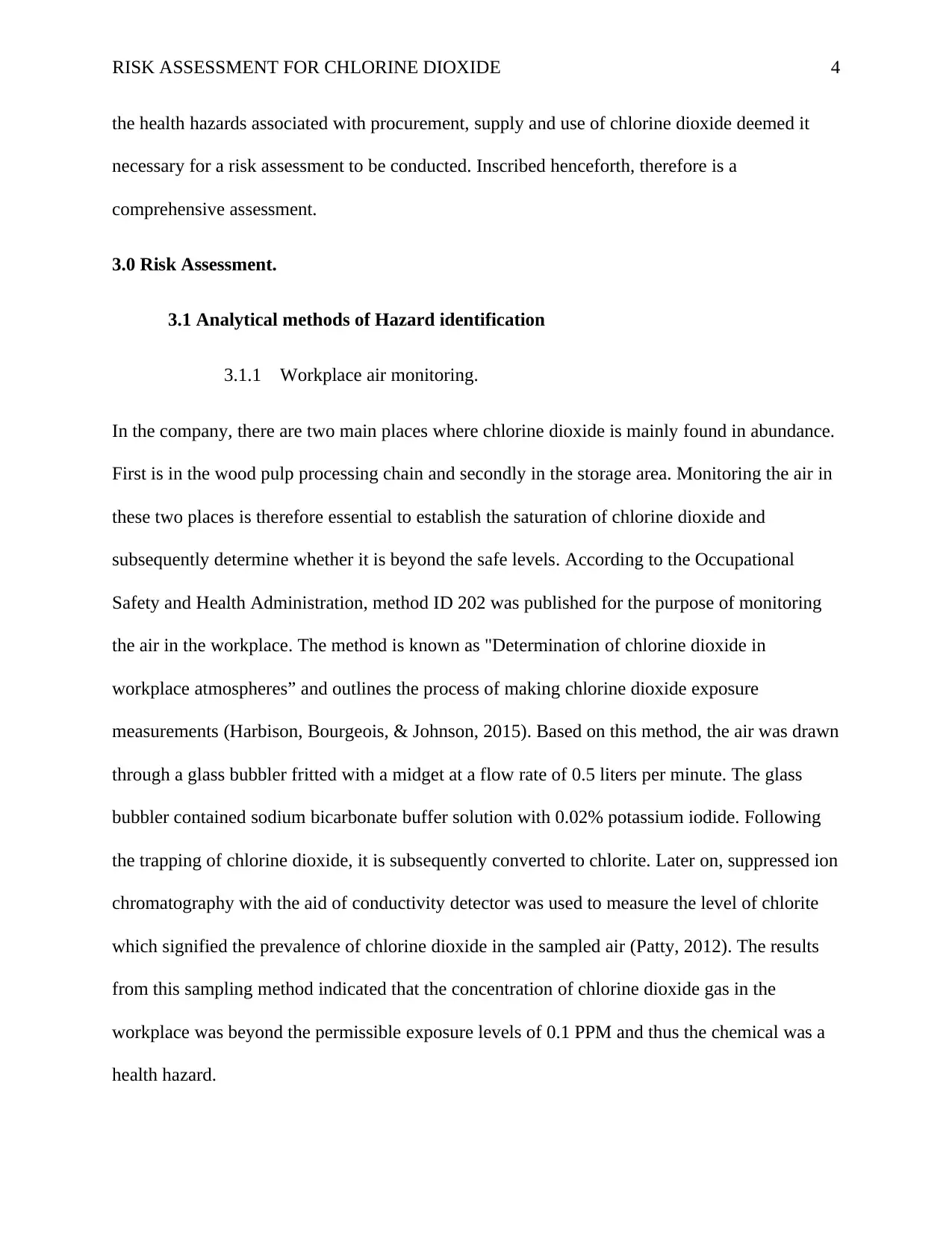
RISK ASSESSMENT FOR CHLORINE DIOXIDE 4
the health hazards associated with procurement, supply and use of chlorine dioxide deemed it
necessary for a risk assessment to be conducted. Inscribed henceforth, therefore is a
comprehensive assessment.
3.0 Risk Assessment.
3.1 Analytical methods of Hazard identification
3.1.1 Workplace air monitoring.
In the company, there are two main places where chlorine dioxide is mainly found in abundance.
First is in the wood pulp processing chain and secondly in the storage area. Monitoring the air in
these two places is therefore essential to establish the saturation of chlorine dioxide and
subsequently determine whether it is beyond the safe levels. According to the Occupational
Safety and Health Administration, method ID 202 was published for the purpose of monitoring
the air in the workplace. The method is known as "Determination of chlorine dioxide in
workplace atmospheres” and outlines the process of making chlorine dioxide exposure
measurements (Harbison, Bourgeois, & Johnson, 2015). Based on this method, the air was drawn
through a glass bubbler fritted with a midget at a flow rate of 0.5 liters per minute. The glass
bubbler contained sodium bicarbonate buffer solution with 0.02% potassium iodide. Following
the trapping of chlorine dioxide, it is subsequently converted to chlorite. Later on, suppressed ion
chromatography with the aid of conductivity detector was used to measure the level of chlorite
which signified the prevalence of chlorine dioxide in the sampled air (Patty, 2012). The results
from this sampling method indicated that the concentration of chlorine dioxide gas in the
workplace was beyond the permissible exposure levels of 0.1 PPM and thus the chemical was a
health hazard.
the health hazards associated with procurement, supply and use of chlorine dioxide deemed it
necessary for a risk assessment to be conducted. Inscribed henceforth, therefore is a
comprehensive assessment.
3.0 Risk Assessment.
3.1 Analytical methods of Hazard identification
3.1.1 Workplace air monitoring.
In the company, there are two main places where chlorine dioxide is mainly found in abundance.
First is in the wood pulp processing chain and secondly in the storage area. Monitoring the air in
these two places is therefore essential to establish the saturation of chlorine dioxide and
subsequently determine whether it is beyond the safe levels. According to the Occupational
Safety and Health Administration, method ID 202 was published for the purpose of monitoring
the air in the workplace. The method is known as "Determination of chlorine dioxide in
workplace atmospheres” and outlines the process of making chlorine dioxide exposure
measurements (Harbison, Bourgeois, & Johnson, 2015). Based on this method, the air was drawn
through a glass bubbler fritted with a midget at a flow rate of 0.5 liters per minute. The glass
bubbler contained sodium bicarbonate buffer solution with 0.02% potassium iodide. Following
the trapping of chlorine dioxide, it is subsequently converted to chlorite. Later on, suppressed ion
chromatography with the aid of conductivity detector was used to measure the level of chlorite
which signified the prevalence of chlorine dioxide in the sampled air (Patty, 2012). The results
from this sampling method indicated that the concentration of chlorine dioxide gas in the
workplace was beyond the permissible exposure levels of 0.1 PPM and thus the chemical was a
health hazard.
Paraphrase This Document
Need a fresh take? Get an instant paraphrase of this document with our AI Paraphraser
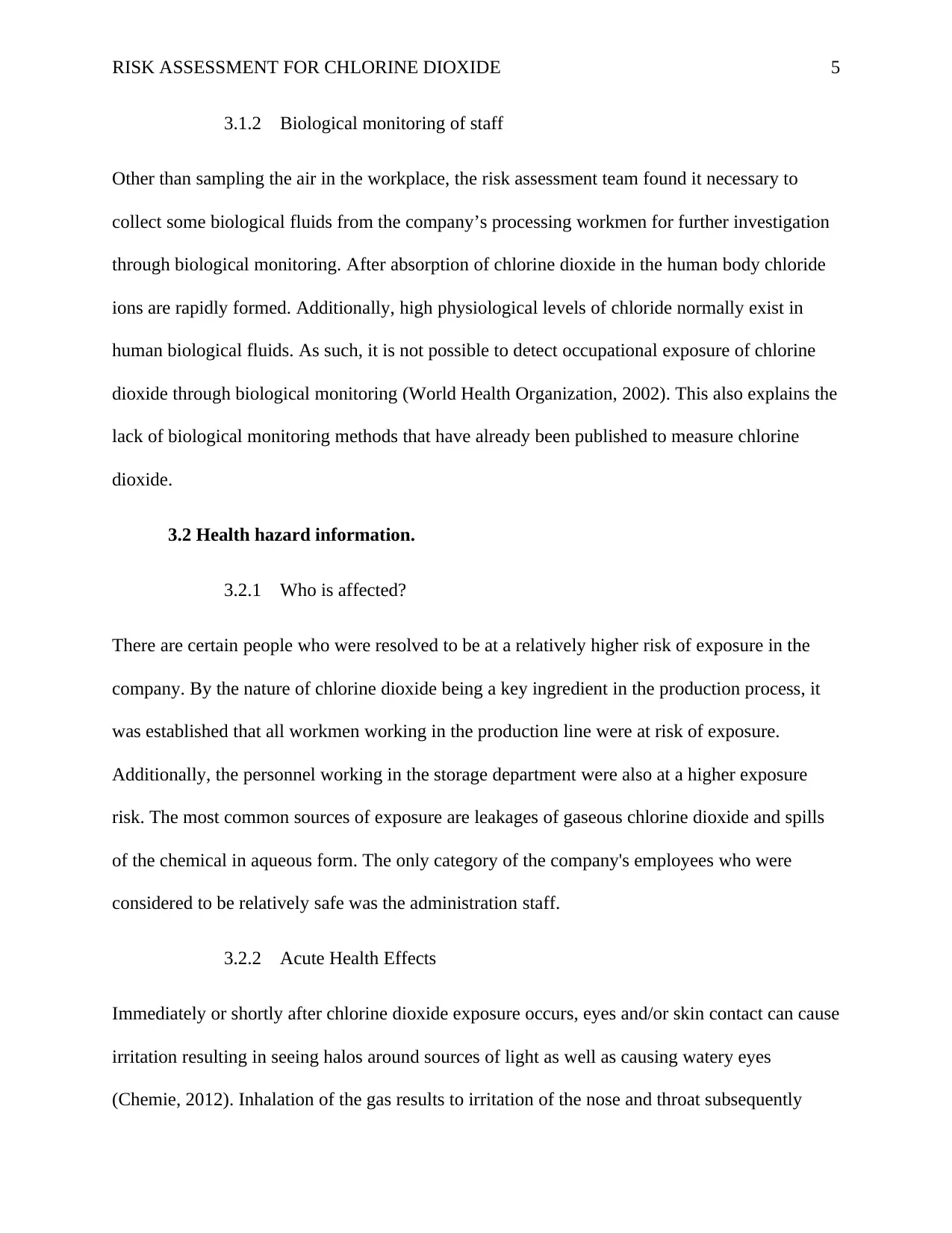
RISK ASSESSMENT FOR CHLORINE DIOXIDE 5
3.1.2 Biological monitoring of staff
Other than sampling the air in the workplace, the risk assessment team found it necessary to
collect some biological fluids from the company’s processing workmen for further investigation
through biological monitoring. After absorption of chlorine dioxide in the human body chloride
ions are rapidly formed. Additionally, high physiological levels of chloride normally exist in
human biological fluids. As such, it is not possible to detect occupational exposure of chlorine
dioxide through biological monitoring (World Health Organization, 2002). This also explains the
lack of biological monitoring methods that have already been published to measure chlorine
dioxide.
3.2 Health hazard information.
3.2.1 Who is affected?
There are certain people who were resolved to be at a relatively higher risk of exposure in the
company. By the nature of chlorine dioxide being a key ingredient in the production process, it
was established that all workmen working in the production line were at risk of exposure.
Additionally, the personnel working in the storage department were also at a higher exposure
risk. The most common sources of exposure are leakages of gaseous chlorine dioxide and spills
of the chemical in aqueous form. The only category of the company's employees who were
considered to be relatively safe was the administration staff.
3.2.2 Acute Health Effects
Immediately or shortly after chlorine dioxide exposure occurs, eyes and/or skin contact can cause
irritation resulting in seeing halos around sources of light as well as causing watery eyes
(Chemie, 2012). Inhalation of the gas results to irritation of the nose and throat subsequently
3.1.2 Biological monitoring of staff
Other than sampling the air in the workplace, the risk assessment team found it necessary to
collect some biological fluids from the company’s processing workmen for further investigation
through biological monitoring. After absorption of chlorine dioxide in the human body chloride
ions are rapidly formed. Additionally, high physiological levels of chloride normally exist in
human biological fluids. As such, it is not possible to detect occupational exposure of chlorine
dioxide through biological monitoring (World Health Organization, 2002). This also explains the
lack of biological monitoring methods that have already been published to measure chlorine
dioxide.
3.2 Health hazard information.
3.2.1 Who is affected?
There are certain people who were resolved to be at a relatively higher risk of exposure in the
company. By the nature of chlorine dioxide being a key ingredient in the production process, it
was established that all workmen working in the production line were at risk of exposure.
Additionally, the personnel working in the storage department were also at a higher exposure
risk. The most common sources of exposure are leakages of gaseous chlorine dioxide and spills
of the chemical in aqueous form. The only category of the company's employees who were
considered to be relatively safe was the administration staff.
3.2.2 Acute Health Effects
Immediately or shortly after chlorine dioxide exposure occurs, eyes and/or skin contact can cause
irritation resulting in seeing halos around sources of light as well as causing watery eyes
(Chemie, 2012). Inhalation of the gas results to irritation of the nose and throat subsequently
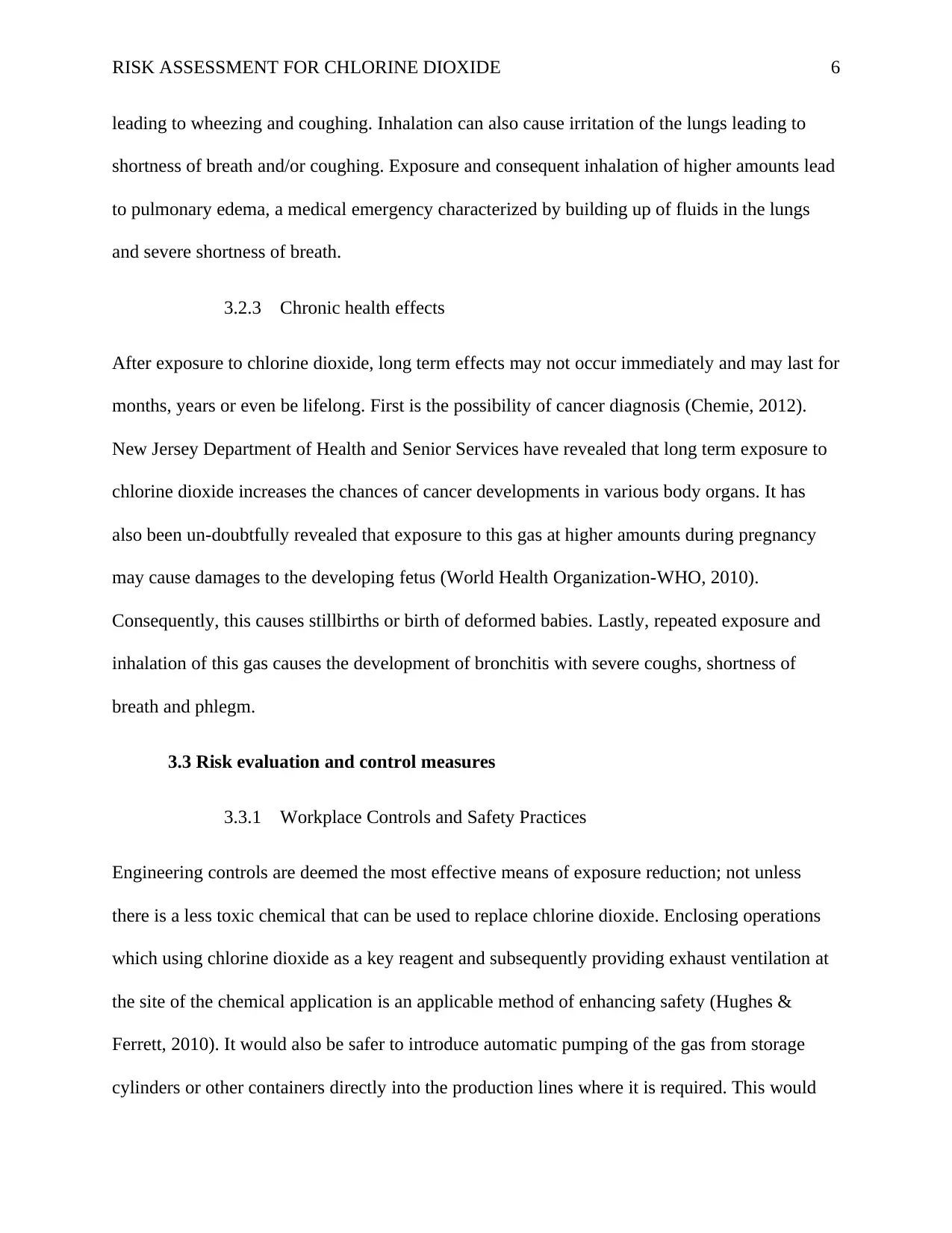
RISK ASSESSMENT FOR CHLORINE DIOXIDE 6
leading to wheezing and coughing. Inhalation can also cause irritation of the lungs leading to
shortness of breath and/or coughing. Exposure and consequent inhalation of higher amounts lead
to pulmonary edema, a medical emergency characterized by building up of fluids in the lungs
and severe shortness of breath.
3.2.3 Chronic health effects
After exposure to chlorine dioxide, long term effects may not occur immediately and may last for
months, years or even be lifelong. First is the possibility of cancer diagnosis (Chemie, 2012).
New Jersey Department of Health and Senior Services have revealed that long term exposure to
chlorine dioxide increases the chances of cancer developments in various body organs. It has
also been un-doubtfully revealed that exposure to this gas at higher amounts during pregnancy
may cause damages to the developing fetus (World Health Organization-WHO, 2010).
Consequently, this causes stillbirths or birth of deformed babies. Lastly, repeated exposure and
inhalation of this gas causes the development of bronchitis with severe coughs, shortness of
breath and phlegm.
3.3 Risk evaluation and control measures
3.3.1 Workplace Controls and Safety Practices
Engineering controls are deemed the most effective means of exposure reduction; not unless
there is a less toxic chemical that can be used to replace chlorine dioxide. Enclosing operations
which using chlorine dioxide as a key reagent and subsequently providing exhaust ventilation at
the site of the chemical application is an applicable method of enhancing safety (Hughes &
Ferrett, 2010). It would also be safer to introduce automatic pumping of the gas from storage
cylinders or other containers directly into the production lines where it is required. This would
leading to wheezing and coughing. Inhalation can also cause irritation of the lungs leading to
shortness of breath and/or coughing. Exposure and consequent inhalation of higher amounts lead
to pulmonary edema, a medical emergency characterized by building up of fluids in the lungs
and severe shortness of breath.
3.2.3 Chronic health effects
After exposure to chlorine dioxide, long term effects may not occur immediately and may last for
months, years or even be lifelong. First is the possibility of cancer diagnosis (Chemie, 2012).
New Jersey Department of Health and Senior Services have revealed that long term exposure to
chlorine dioxide increases the chances of cancer developments in various body organs. It has
also been un-doubtfully revealed that exposure to this gas at higher amounts during pregnancy
may cause damages to the developing fetus (World Health Organization-WHO, 2010).
Consequently, this causes stillbirths or birth of deformed babies. Lastly, repeated exposure and
inhalation of this gas causes the development of bronchitis with severe coughs, shortness of
breath and phlegm.
3.3 Risk evaluation and control measures
3.3.1 Workplace Controls and Safety Practices
Engineering controls are deemed the most effective means of exposure reduction; not unless
there is a less toxic chemical that can be used to replace chlorine dioxide. Enclosing operations
which using chlorine dioxide as a key reagent and subsequently providing exhaust ventilation at
the site of the chemical application is an applicable method of enhancing safety (Hughes &
Ferrett, 2010). It would also be safer to introduce automatic pumping of the gas from storage
cylinders or other containers directly into the production lines where it is required. This would
You're viewing a preview
Unlock full access by subscribing today!
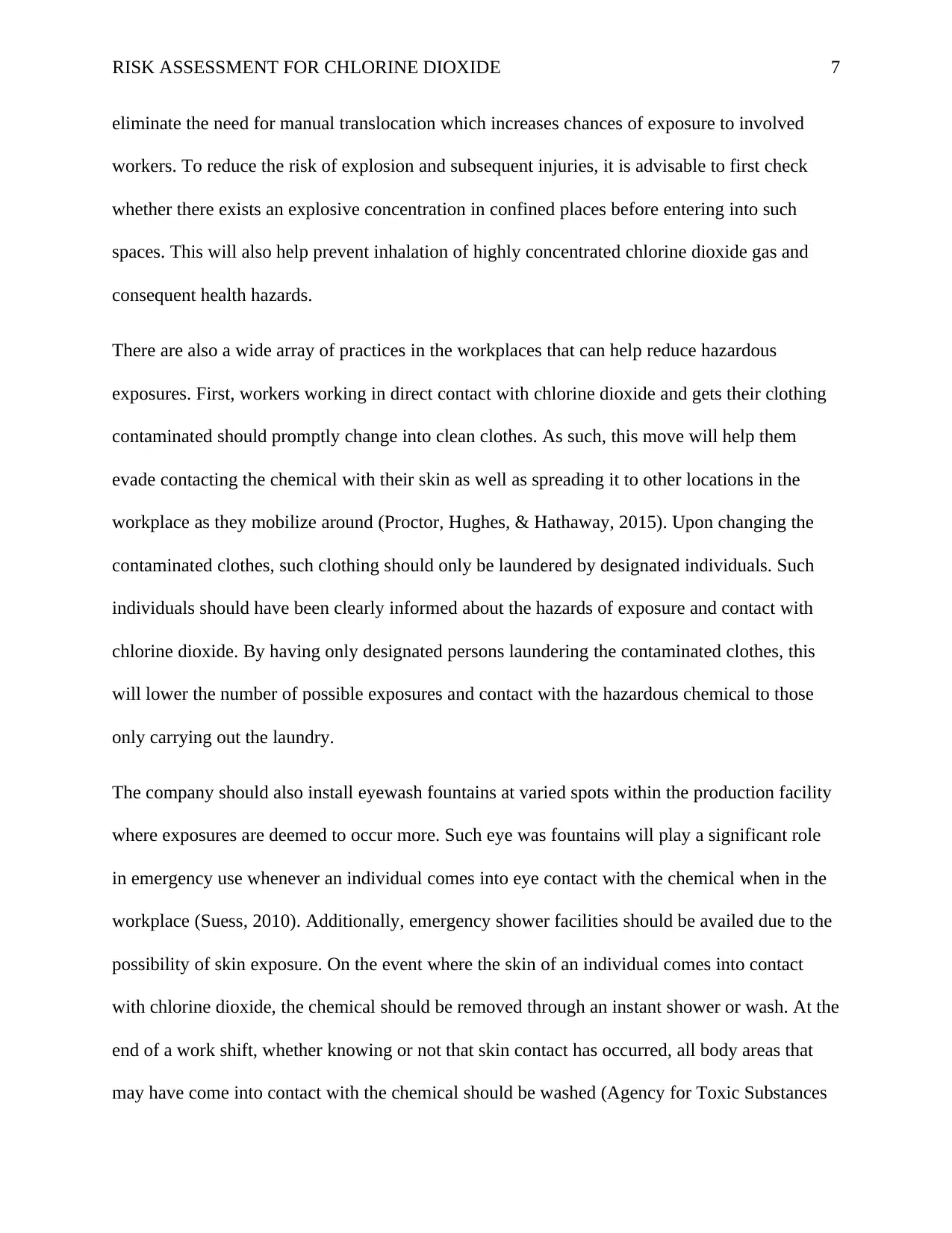
RISK ASSESSMENT FOR CHLORINE DIOXIDE 7
eliminate the need for manual translocation which increases chances of exposure to involved
workers. To reduce the risk of explosion and subsequent injuries, it is advisable to first check
whether there exists an explosive concentration in confined places before entering into such
spaces. This will also help prevent inhalation of highly concentrated chlorine dioxide gas and
consequent health hazards.
There are also a wide array of practices in the workplaces that can help reduce hazardous
exposures. First, workers working in direct contact with chlorine dioxide and gets their clothing
contaminated should promptly change into clean clothes. As such, this move will help them
evade contacting the chemical with their skin as well as spreading it to other locations in the
workplace as they mobilize around (Proctor, Hughes, & Hathaway, 2015). Upon changing the
contaminated clothes, such clothing should only be laundered by designated individuals. Such
individuals should have been clearly informed about the hazards of exposure and contact with
chlorine dioxide. By having only designated persons laundering the contaminated clothes, this
will lower the number of possible exposures and contact with the hazardous chemical to those
only carrying out the laundry.
The company should also install eyewash fountains at varied spots within the production facility
where exposures are deemed to occur more. Such eye was fountains will play a significant role
in emergency use whenever an individual comes into eye contact with the chemical when in the
workplace (Suess, 2010). Additionally, emergency shower facilities should be availed due to the
possibility of skin exposure. On the event where the skin of an individual comes into contact
with chlorine dioxide, the chemical should be removed through an instant shower or wash. At the
end of a work shift, whether knowing or not that skin contact has occurred, all body areas that
may have come into contact with the chemical should be washed (Agency for Toxic Substances
eliminate the need for manual translocation which increases chances of exposure to involved
workers. To reduce the risk of explosion and subsequent injuries, it is advisable to first check
whether there exists an explosive concentration in confined places before entering into such
spaces. This will also help prevent inhalation of highly concentrated chlorine dioxide gas and
consequent health hazards.
There are also a wide array of practices in the workplaces that can help reduce hazardous
exposures. First, workers working in direct contact with chlorine dioxide and gets their clothing
contaminated should promptly change into clean clothes. As such, this move will help them
evade contacting the chemical with their skin as well as spreading it to other locations in the
workplace as they mobilize around (Proctor, Hughes, & Hathaway, 2015). Upon changing the
contaminated clothes, such clothing should only be laundered by designated individuals. Such
individuals should have been clearly informed about the hazards of exposure and contact with
chlorine dioxide. By having only designated persons laundering the contaminated clothes, this
will lower the number of possible exposures and contact with the hazardous chemical to those
only carrying out the laundry.
The company should also install eyewash fountains at varied spots within the production facility
where exposures are deemed to occur more. Such eye was fountains will play a significant role
in emergency use whenever an individual comes into eye contact with the chemical when in the
workplace (Suess, 2010). Additionally, emergency shower facilities should be availed due to the
possibility of skin exposure. On the event where the skin of an individual comes into contact
with chlorine dioxide, the chemical should be removed through an instant shower or wash. At the
end of a work shift, whether knowing or not that skin contact has occurred, all body areas that
may have come into contact with the chemical should be washed (Agency for Toxic Substances
Paraphrase This Document
Need a fresh take? Get an instant paraphrase of this document with our AI Paraphraser
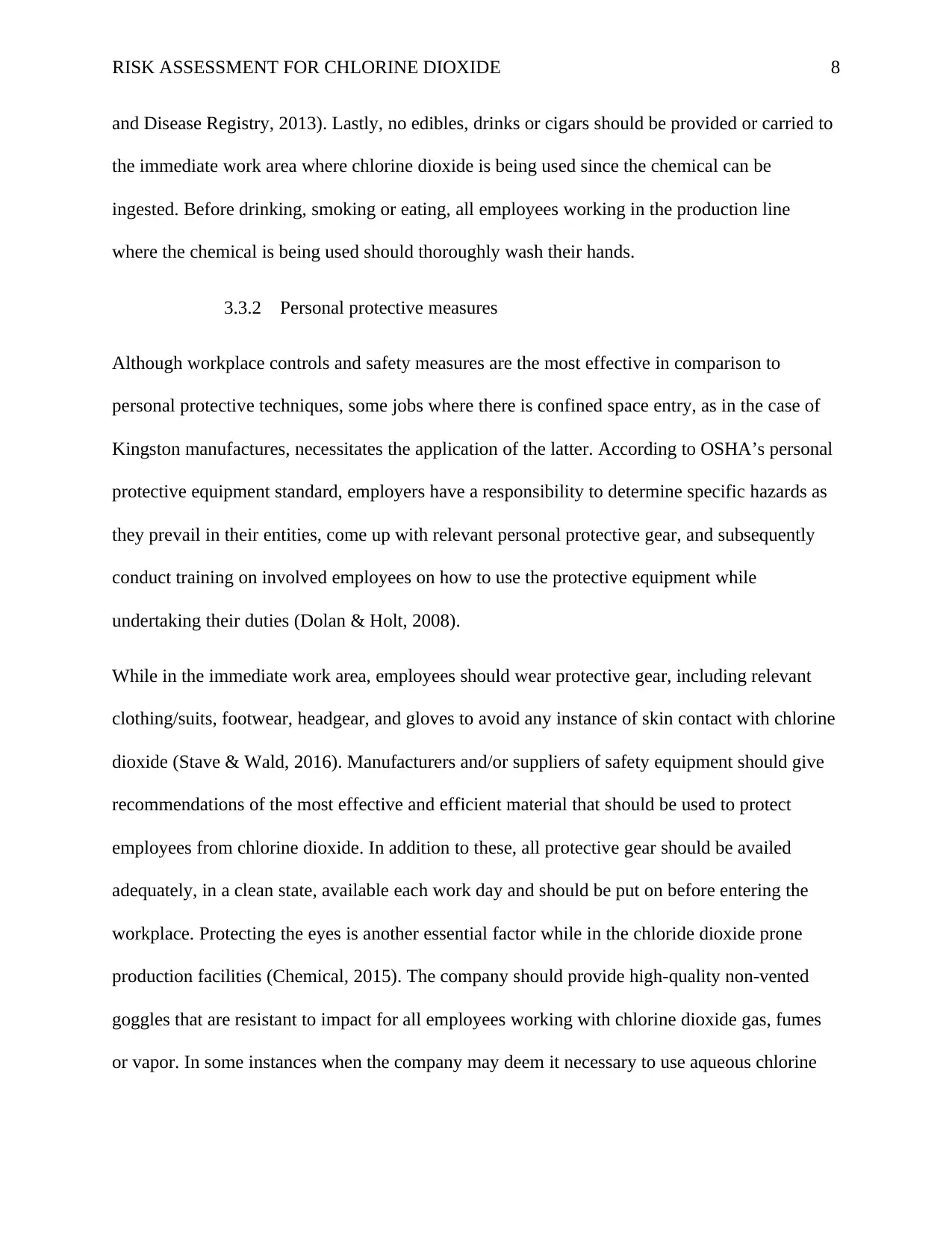
RISK ASSESSMENT FOR CHLORINE DIOXIDE 8
and Disease Registry, 2013). Lastly, no edibles, drinks or cigars should be provided or carried to
the immediate work area where chlorine dioxide is being used since the chemical can be
ingested. Before drinking, smoking or eating, all employees working in the production line
where the chemical is being used should thoroughly wash their hands.
3.3.2 Personal protective measures
Although workplace controls and safety measures are the most effective in comparison to
personal protective techniques, some jobs where there is confined space entry, as in the case of
Kingston manufactures, necessitates the application of the latter. According to OSHA’s personal
protective equipment standard, employers have a responsibility to determine specific hazards as
they prevail in their entities, come up with relevant personal protective gear, and subsequently
conduct training on involved employees on how to use the protective equipment while
undertaking their duties (Dolan & Holt, 2008).
While in the immediate work area, employees should wear protective gear, including relevant
clothing/suits, footwear, headgear, and gloves to avoid any instance of skin contact with chlorine
dioxide (Stave & Wald, 2016). Manufacturers and/or suppliers of safety equipment should give
recommendations of the most effective and efficient material that should be used to protect
employees from chlorine dioxide. In addition to these, all protective gear should be availed
adequately, in a clean state, available each work day and should be put on before entering the
workplace. Protecting the eyes is another essential factor while in the chloride dioxide prone
production facilities (Chemical, 2015). The company should provide high-quality non-vented
goggles that are resistant to impact for all employees working with chlorine dioxide gas, fumes
or vapor. In some instances when the company may deem it necessary to use aqueous chlorine
and Disease Registry, 2013). Lastly, no edibles, drinks or cigars should be provided or carried to
the immediate work area where chlorine dioxide is being used since the chemical can be
ingested. Before drinking, smoking or eating, all employees working in the production line
where the chemical is being used should thoroughly wash their hands.
3.3.2 Personal protective measures
Although workplace controls and safety measures are the most effective in comparison to
personal protective techniques, some jobs where there is confined space entry, as in the case of
Kingston manufactures, necessitates the application of the latter. According to OSHA’s personal
protective equipment standard, employers have a responsibility to determine specific hazards as
they prevail in their entities, come up with relevant personal protective gear, and subsequently
conduct training on involved employees on how to use the protective equipment while
undertaking their duties (Dolan & Holt, 2008).
While in the immediate work area, employees should wear protective gear, including relevant
clothing/suits, footwear, headgear, and gloves to avoid any instance of skin contact with chlorine
dioxide (Stave & Wald, 2016). Manufacturers and/or suppliers of safety equipment should give
recommendations of the most effective and efficient material that should be used to protect
employees from chlorine dioxide. In addition to these, all protective gear should be availed
adequately, in a clean state, available each work day and should be put on before entering the
workplace. Protecting the eyes is another essential factor while in the chloride dioxide prone
production facilities (Chemical, 2015). The company should provide high-quality non-vented
goggles that are resistant to impact for all employees working with chlorine dioxide gas, fumes
or vapor. In some instances when the company may deem it necessary to use aqueous chlorine
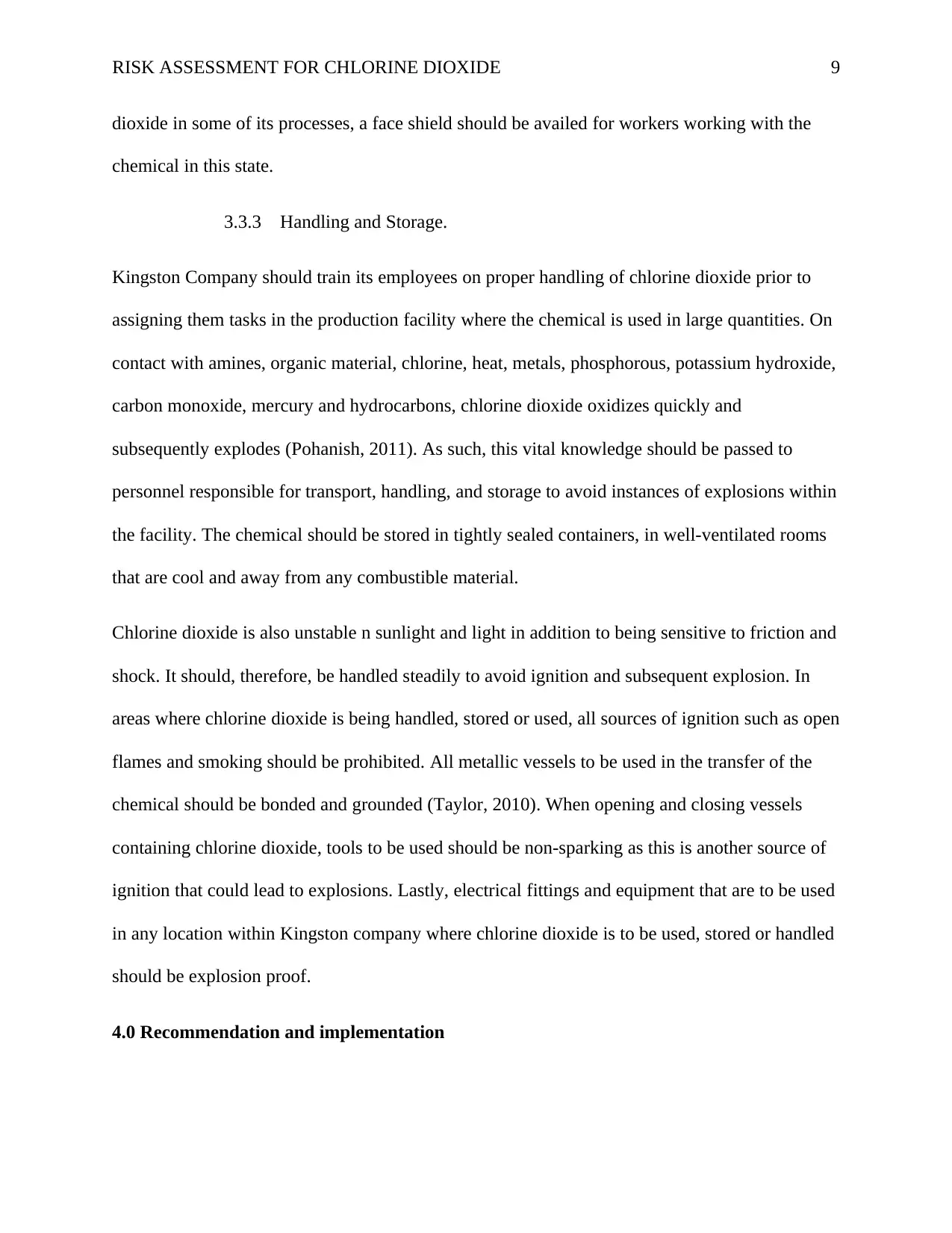
RISK ASSESSMENT FOR CHLORINE DIOXIDE 9
dioxide in some of its processes, a face shield should be availed for workers working with the
chemical in this state.
3.3.3 Handling and Storage.
Kingston Company should train its employees on proper handling of chlorine dioxide prior to
assigning them tasks in the production facility where the chemical is used in large quantities. On
contact with amines, organic material, chlorine, heat, metals, phosphorous, potassium hydroxide,
carbon monoxide, mercury and hydrocarbons, chlorine dioxide oxidizes quickly and
subsequently explodes (Pohanish, 2011). As such, this vital knowledge should be passed to
personnel responsible for transport, handling, and storage to avoid instances of explosions within
the facility. The chemical should be stored in tightly sealed containers, in well-ventilated rooms
that are cool and away from any combustible material.
Chlorine dioxide is also unstable n sunlight and light in addition to being sensitive to friction and
shock. It should, therefore, be handled steadily to avoid ignition and subsequent explosion. In
areas where chlorine dioxide is being handled, stored or used, all sources of ignition such as open
flames and smoking should be prohibited. All metallic vessels to be used in the transfer of the
chemical should be bonded and grounded (Taylor, 2010). When opening and closing vessels
containing chlorine dioxide, tools to be used should be non-sparking as this is another source of
ignition that could lead to explosions. Lastly, electrical fittings and equipment that are to be used
in any location within Kingston company where chlorine dioxide is to be used, stored or handled
should be explosion proof.
4.0 Recommendation and implementation
dioxide in some of its processes, a face shield should be availed for workers working with the
chemical in this state.
3.3.3 Handling and Storage.
Kingston Company should train its employees on proper handling of chlorine dioxide prior to
assigning them tasks in the production facility where the chemical is used in large quantities. On
contact with amines, organic material, chlorine, heat, metals, phosphorous, potassium hydroxide,
carbon monoxide, mercury and hydrocarbons, chlorine dioxide oxidizes quickly and
subsequently explodes (Pohanish, 2011). As such, this vital knowledge should be passed to
personnel responsible for transport, handling, and storage to avoid instances of explosions within
the facility. The chemical should be stored in tightly sealed containers, in well-ventilated rooms
that are cool and away from any combustible material.
Chlorine dioxide is also unstable n sunlight and light in addition to being sensitive to friction and
shock. It should, therefore, be handled steadily to avoid ignition and subsequent explosion. In
areas where chlorine dioxide is being handled, stored or used, all sources of ignition such as open
flames and smoking should be prohibited. All metallic vessels to be used in the transfer of the
chemical should be bonded and grounded (Taylor, 2010). When opening and closing vessels
containing chlorine dioxide, tools to be used should be non-sparking as this is another source of
ignition that could lead to explosions. Lastly, electrical fittings and equipment that are to be used
in any location within Kingston company where chlorine dioxide is to be used, stored or handled
should be explosion proof.
4.0 Recommendation and implementation
You're viewing a preview
Unlock full access by subscribing today!
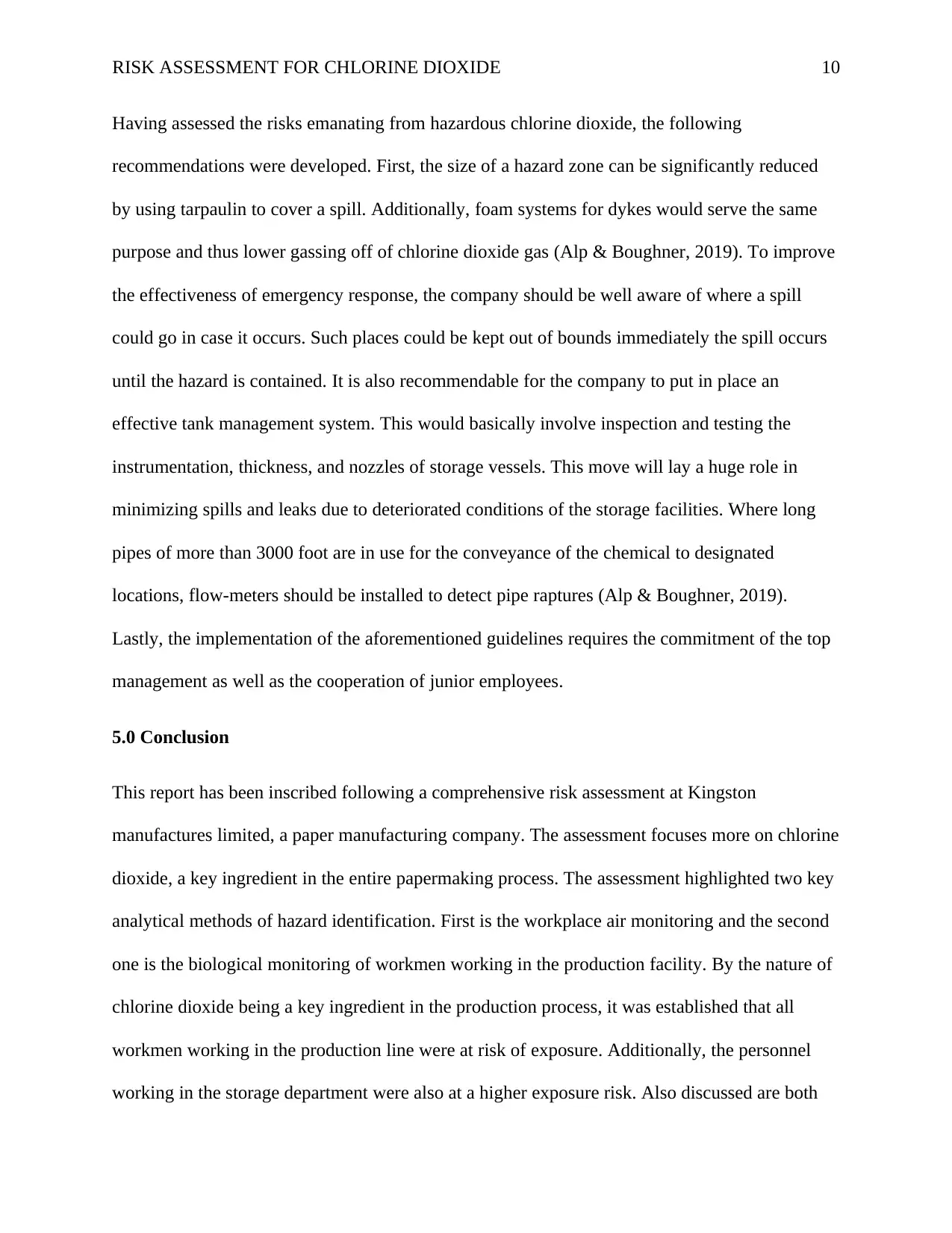
RISK ASSESSMENT FOR CHLORINE DIOXIDE 10
Having assessed the risks emanating from hazardous chlorine dioxide, the following
recommendations were developed. First, the size of a hazard zone can be significantly reduced
by using tarpaulin to cover a spill. Additionally, foam systems for dykes would serve the same
purpose and thus lower gassing off of chlorine dioxide gas (Alp & Boughner, 2019). To improve
the effectiveness of emergency response, the company should be well aware of where a spill
could go in case it occurs. Such places could be kept out of bounds immediately the spill occurs
until the hazard is contained. It is also recommendable for the company to put in place an
effective tank management system. This would basically involve inspection and testing the
instrumentation, thickness, and nozzles of storage vessels. This move will lay a huge role in
minimizing spills and leaks due to deteriorated conditions of the storage facilities. Where long
pipes of more than 3000 foot are in use for the conveyance of the chemical to designated
locations, flow-meters should be installed to detect pipe raptures (Alp & Boughner, 2019).
Lastly, the implementation of the aforementioned guidelines requires the commitment of the top
management as well as the cooperation of junior employees.
5.0 Conclusion
This report has been inscribed following a comprehensive risk assessment at Kingston
manufactures limited, a paper manufacturing company. The assessment focuses more on chlorine
dioxide, a key ingredient in the entire papermaking process. The assessment highlighted two key
analytical methods of hazard identification. First is the workplace air monitoring and the second
one is the biological monitoring of workmen working in the production facility. By the nature of
chlorine dioxide being a key ingredient in the production process, it was established that all
workmen working in the production line were at risk of exposure. Additionally, the personnel
working in the storage department were also at a higher exposure risk. Also discussed are both
Having assessed the risks emanating from hazardous chlorine dioxide, the following
recommendations were developed. First, the size of a hazard zone can be significantly reduced
by using tarpaulin to cover a spill. Additionally, foam systems for dykes would serve the same
purpose and thus lower gassing off of chlorine dioxide gas (Alp & Boughner, 2019). To improve
the effectiveness of emergency response, the company should be well aware of where a spill
could go in case it occurs. Such places could be kept out of bounds immediately the spill occurs
until the hazard is contained. It is also recommendable for the company to put in place an
effective tank management system. This would basically involve inspection and testing the
instrumentation, thickness, and nozzles of storage vessels. This move will lay a huge role in
minimizing spills and leaks due to deteriorated conditions of the storage facilities. Where long
pipes of more than 3000 foot are in use for the conveyance of the chemical to designated
locations, flow-meters should be installed to detect pipe raptures (Alp & Boughner, 2019).
Lastly, the implementation of the aforementioned guidelines requires the commitment of the top
management as well as the cooperation of junior employees.
5.0 Conclusion
This report has been inscribed following a comprehensive risk assessment at Kingston
manufactures limited, a paper manufacturing company. The assessment focuses more on chlorine
dioxide, a key ingredient in the entire papermaking process. The assessment highlighted two key
analytical methods of hazard identification. First is the workplace air monitoring and the second
one is the biological monitoring of workmen working in the production facility. By the nature of
chlorine dioxide being a key ingredient in the production process, it was established that all
workmen working in the production line were at risk of exposure. Additionally, the personnel
working in the storage department were also at a higher exposure risk. Also discussed are both
Paraphrase This Document
Need a fresh take? Get an instant paraphrase of this document with our AI Paraphraser
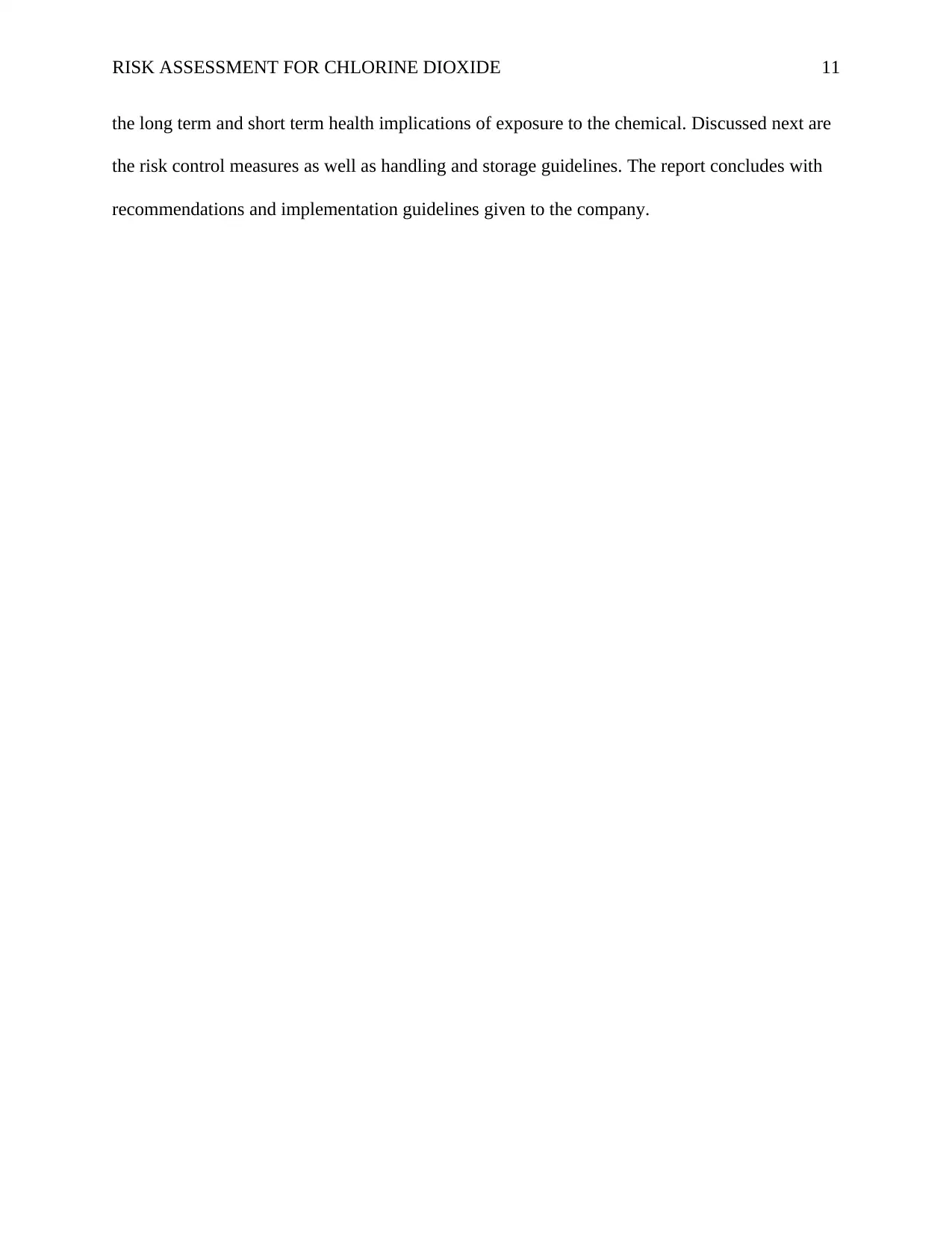
RISK ASSESSMENT FOR CHLORINE DIOXIDE 11
the long term and short term health implications of exposure to the chemical. Discussed next are
the risk control measures as well as handling and storage guidelines. The report concludes with
recommendations and implementation guidelines given to the company.
the long term and short term health implications of exposure to the chemical. Discussed next are
the risk control measures as well as handling and storage guidelines. The report concludes with
recommendations and implementation guidelines given to the company.
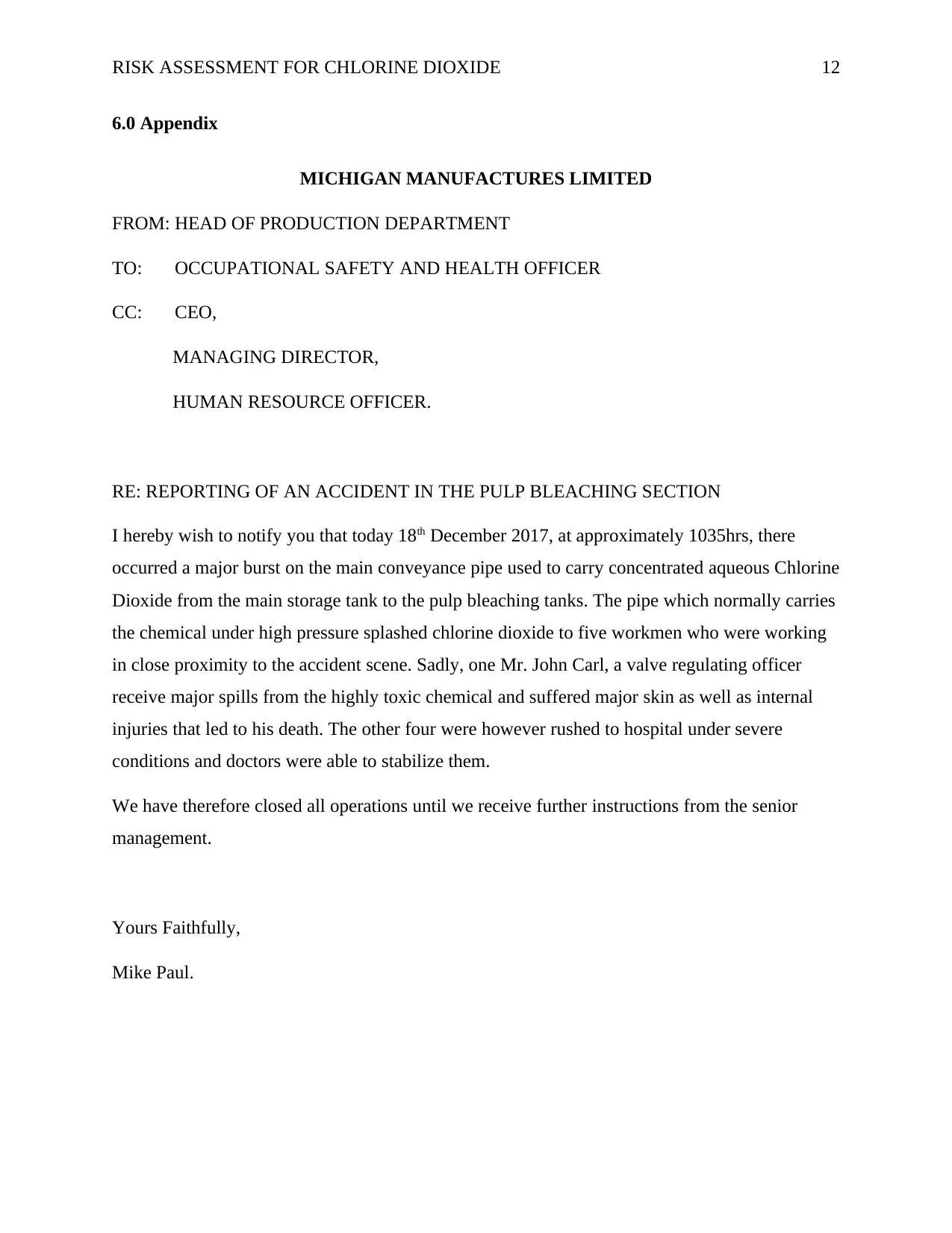
RISK ASSESSMENT FOR CHLORINE DIOXIDE 12
6.0 Appendix
MICHIGAN MANUFACTURES LIMITED
FROM: HEAD OF PRODUCTION DEPARTMENT
TO: OCCUPATIONAL SAFETY AND HEALTH OFFICER
CC: CEO,
MANAGING DIRECTOR,
HUMAN RESOURCE OFFICER.
RE: REPORTING OF AN ACCIDENT IN THE PULP BLEACHING SECTION
I hereby wish to notify you that today 18th December 2017, at approximately 1035hrs, there
occurred a major burst on the main conveyance pipe used to carry concentrated aqueous Chlorine
Dioxide from the main storage tank to the pulp bleaching tanks. The pipe which normally carries
the chemical under high pressure splashed chlorine dioxide to five workmen who were working
in close proximity to the accident scene. Sadly, one Mr. John Carl, a valve regulating officer
receive major spills from the highly toxic chemical and suffered major skin as well as internal
injuries that led to his death. The other four were however rushed to hospital under severe
conditions and doctors were able to stabilize them.
We have therefore closed all operations until we receive further instructions from the senior
management.
Yours Faithfully,
Mike Paul.
6.0 Appendix
MICHIGAN MANUFACTURES LIMITED
FROM: HEAD OF PRODUCTION DEPARTMENT
TO: OCCUPATIONAL SAFETY AND HEALTH OFFICER
CC: CEO,
MANAGING DIRECTOR,
HUMAN RESOURCE OFFICER.
RE: REPORTING OF AN ACCIDENT IN THE PULP BLEACHING SECTION
I hereby wish to notify you that today 18th December 2017, at approximately 1035hrs, there
occurred a major burst on the main conveyance pipe used to carry concentrated aqueous Chlorine
Dioxide from the main storage tank to the pulp bleaching tanks. The pipe which normally carries
the chemical under high pressure splashed chlorine dioxide to five workmen who were working
in close proximity to the accident scene. Sadly, one Mr. John Carl, a valve regulating officer
receive major spills from the highly toxic chemical and suffered major skin as well as internal
injuries that led to his death. The other four were however rushed to hospital under severe
conditions and doctors were able to stabilize them.
We have therefore closed all operations until we receive further instructions from the senior
management.
Yours Faithfully,
Mike Paul.
You're viewing a preview
Unlock full access by subscribing today!
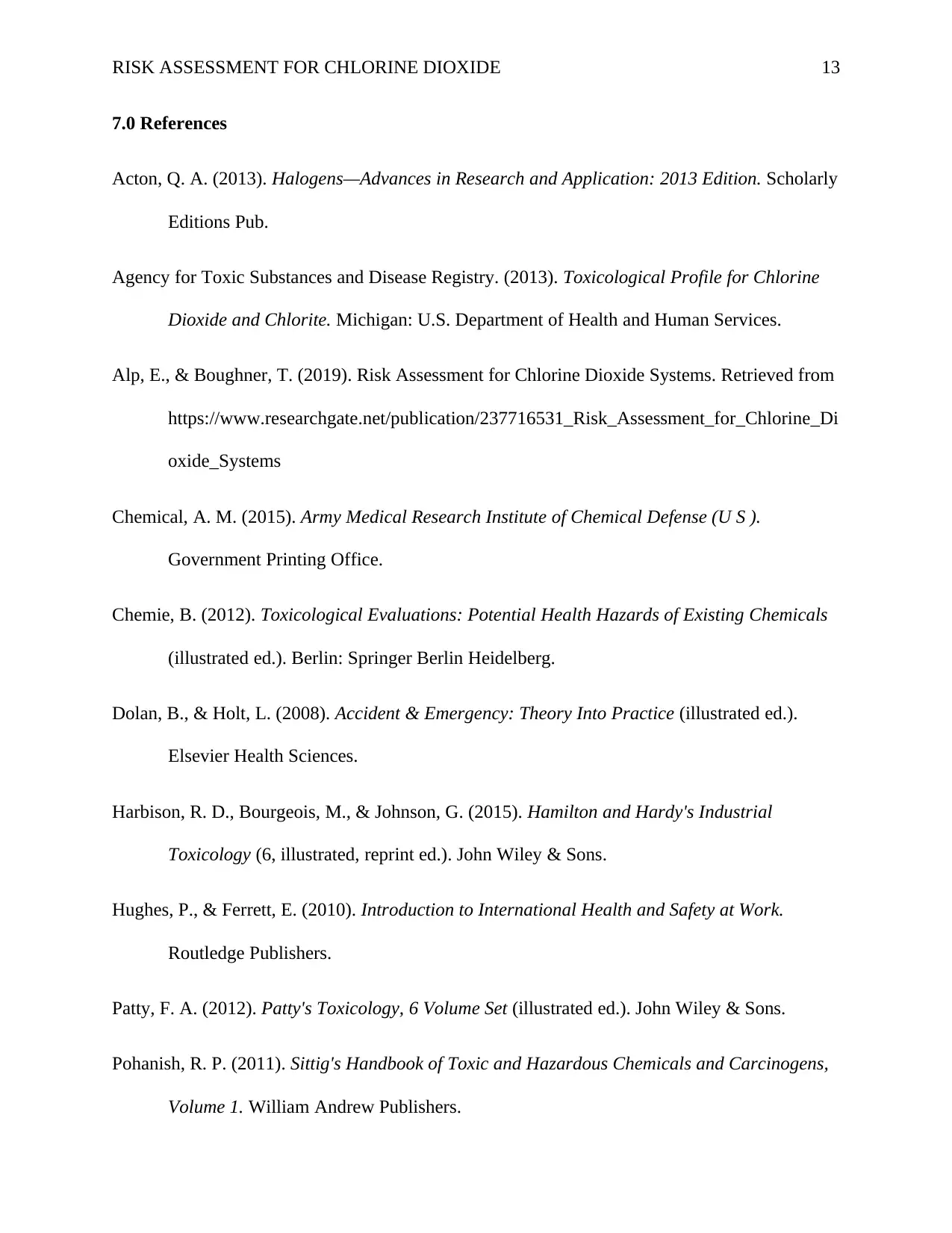
RISK ASSESSMENT FOR CHLORINE DIOXIDE 13
7.0 References
Acton, Q. A. (2013). Halogens—Advances in Research and Application: 2013 Edition. Scholarly
Editions Pub.
Agency for Toxic Substances and Disease Registry. (2013). Toxicological Profile for Chlorine
Dioxide and Chlorite. Michigan: U.S. Department of Health and Human Services.
Alp, E., & Boughner, T. (2019). Risk Assessment for Chlorine Dioxide Systems. Retrieved from
https://www.researchgate.net/publication/237716531_Risk_Assessment_for_Chlorine_Di
oxide_Systems
Chemical, A. M. (2015). Army Medical Research Institute of Chemical Defense (U S ).
Government Printing Office.
Chemie, B. (2012). Toxicological Evaluations: Potential Health Hazards of Existing Chemicals
(illustrated ed.). Berlin: Springer Berlin Heidelberg.
Dolan, B., & Holt, L. (2008). Accident & Emergency: Theory Into Practice (illustrated ed.).
Elsevier Health Sciences.
Harbison, R. D., Bourgeois, M., & Johnson, G. (2015). Hamilton and Hardy's Industrial
Toxicology (6, illustrated, reprint ed.). John Wiley & Sons.
Hughes, P., & Ferrett, E. (2010). Introduction to International Health and Safety at Work.
Routledge Publishers.
Patty, F. A. (2012). Patty's Toxicology, 6 Volume Set (illustrated ed.). John Wiley & Sons.
Pohanish, R. P. (2011). Sittig's Handbook of Toxic and Hazardous Chemicals and Carcinogens,
Volume 1. William Andrew Publishers.
7.0 References
Acton, Q. A. (2013). Halogens—Advances in Research and Application: 2013 Edition. Scholarly
Editions Pub.
Agency for Toxic Substances and Disease Registry. (2013). Toxicological Profile for Chlorine
Dioxide and Chlorite. Michigan: U.S. Department of Health and Human Services.
Alp, E., & Boughner, T. (2019). Risk Assessment for Chlorine Dioxide Systems. Retrieved from
https://www.researchgate.net/publication/237716531_Risk_Assessment_for_Chlorine_Di
oxide_Systems
Chemical, A. M. (2015). Army Medical Research Institute of Chemical Defense (U S ).
Government Printing Office.
Chemie, B. (2012). Toxicological Evaluations: Potential Health Hazards of Existing Chemicals
(illustrated ed.). Berlin: Springer Berlin Heidelberg.
Dolan, B., & Holt, L. (2008). Accident & Emergency: Theory Into Practice (illustrated ed.).
Elsevier Health Sciences.
Harbison, R. D., Bourgeois, M., & Johnson, G. (2015). Hamilton and Hardy's Industrial
Toxicology (6, illustrated, reprint ed.). John Wiley & Sons.
Hughes, P., & Ferrett, E. (2010). Introduction to International Health and Safety at Work.
Routledge Publishers.
Patty, F. A. (2012). Patty's Toxicology, 6 Volume Set (illustrated ed.). John Wiley & Sons.
Pohanish, R. P. (2011). Sittig's Handbook of Toxic and Hazardous Chemicals and Carcinogens,
Volume 1. William Andrew Publishers.
Paraphrase This Document
Need a fresh take? Get an instant paraphrase of this document with our AI Paraphraser
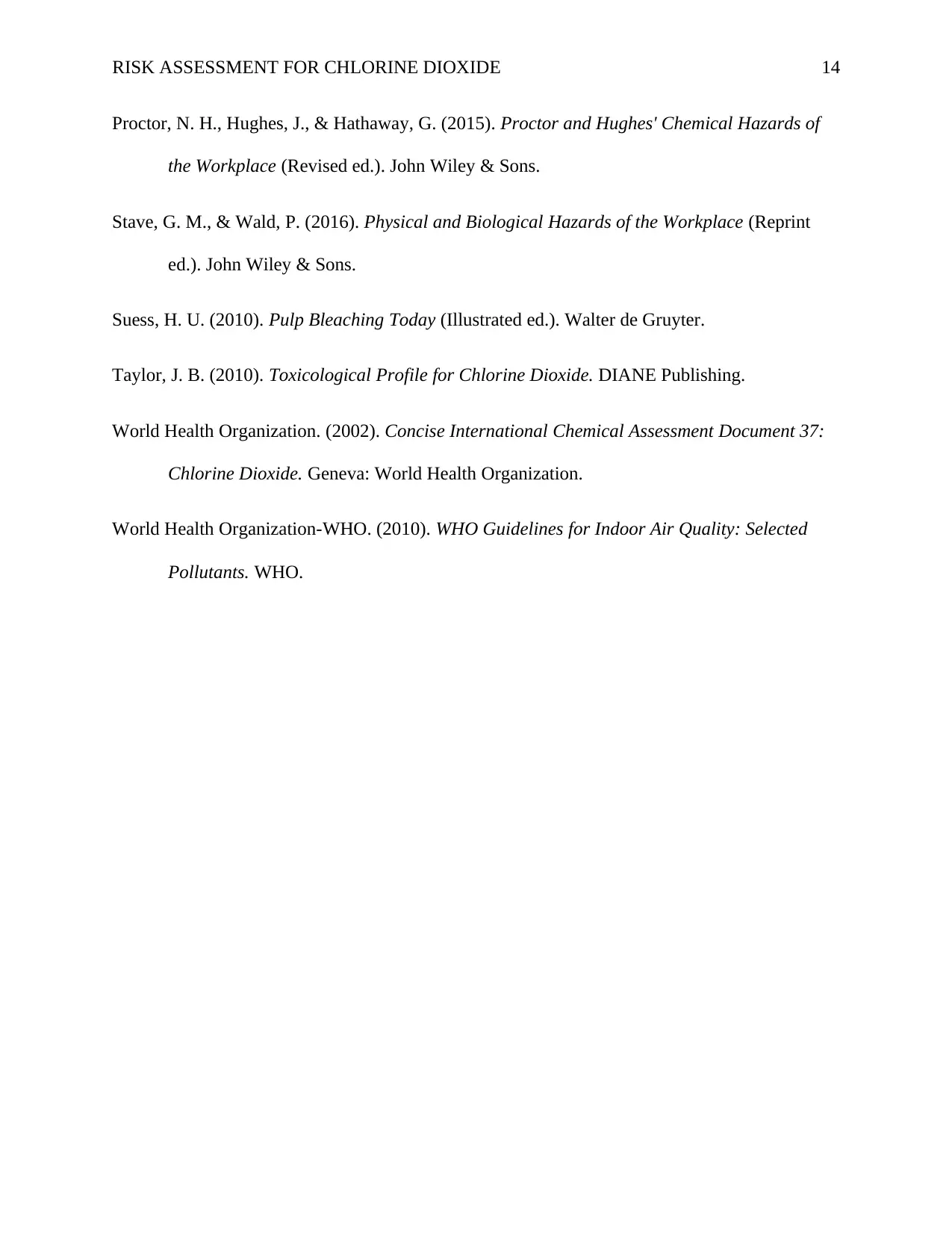
RISK ASSESSMENT FOR CHLORINE DIOXIDE 14
Proctor, N. H., Hughes, J., & Hathaway, G. (2015). Proctor and Hughes' Chemical Hazards of
the Workplace (Revised ed.). John Wiley & Sons.
Stave, G. M., & Wald, P. (2016). Physical and Biological Hazards of the Workplace (Reprint
ed.). John Wiley & Sons.
Suess, H. U. (2010). Pulp Bleaching Today (Illustrated ed.). Walter de Gruyter.
Taylor, J. B. (2010). Toxicological Profile for Chlorine Dioxide. DIANE Publishing.
World Health Organization. (2002). Concise International Chemical Assessment Document 37:
Chlorine Dioxide. Geneva: World Health Organization.
World Health Organization-WHO. (2010). WHO Guidelines for Indoor Air Quality: Selected
Pollutants. WHO.
Proctor, N. H., Hughes, J., & Hathaway, G. (2015). Proctor and Hughes' Chemical Hazards of
the Workplace (Revised ed.). John Wiley & Sons.
Stave, G. M., & Wald, P. (2016). Physical and Biological Hazards of the Workplace (Reprint
ed.). John Wiley & Sons.
Suess, H. U. (2010). Pulp Bleaching Today (Illustrated ed.). Walter de Gruyter.
Taylor, J. B. (2010). Toxicological Profile for Chlorine Dioxide. DIANE Publishing.
World Health Organization. (2002). Concise International Chemical Assessment Document 37:
Chlorine Dioxide. Geneva: World Health Organization.
World Health Organization-WHO. (2010). WHO Guidelines for Indoor Air Quality: Selected
Pollutants. WHO.
1 out of 14
Your All-in-One AI-Powered Toolkit for Academic Success.
+13062052269
info@desklib.com
Available 24*7 on WhatsApp / Email
![[object Object]](/_next/static/media/star-bottom.7253800d.svg)
Unlock your academic potential
© 2024 | Zucol Services PVT LTD | All rights reserved.
